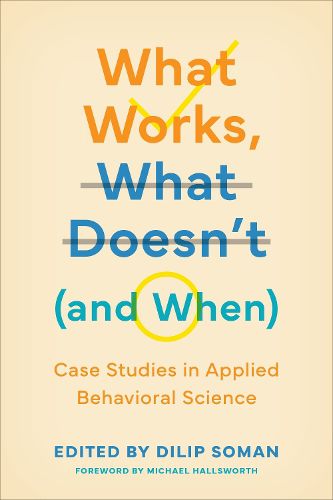Readings Newsletter
Become a Readings Member to make your shopping experience even easier.
Sign in or sign up for free!
You’re not far away from qualifying for FREE standard shipping within Australia
You’ve qualified for FREE standard shipping within Australia
The cart is loading…






How well do behavioral science interventions translate and scale in the real world? Consider a practitioner who is looking to create behavior change through an intervention perhaps it involves getting people to conserve energy, increase compliance with a medication regime, reduce misinformation, or improve tax collection. The behavioral science practitioner will typically draw inspiration from a previous study or intervention to translate into their own intervention.
The latest book in the Behaviourally Informed Organizations series, What Works, What Doesn't (and When) presents a collection of studies in applied behavioral research with a behind-the-scenes look at how the project actually unfolded. Using seventeen case studies of such translation and scaling projects in diverse domains such as financial decisions, health, energy conservation, development, reducing absenteeism, diversity and inclusion, and reducing fare evasion, the book outlines the processes, the potential pitfalls, as well as some prescriptions on how to enhance the success of behavioral interventions. The cases show how behavioral science research is done from getting inspiration to adapting research into context, designing tailored interventions, and comparing and reconciling results.
With contributions from leading academics and seasoned practitioners, What Works, What Doesn't (and When) provides prescriptive advice on how to make behavior change projects happen and what pitfalls to watch out for.
$9.00 standard shipping within Australia
FREE standard shipping within Australia for orders over $100.00
Express & International shipping calculated at checkout
How well do behavioral science interventions translate and scale in the real world? Consider a practitioner who is looking to create behavior change through an intervention perhaps it involves getting people to conserve energy, increase compliance with a medication regime, reduce misinformation, or improve tax collection. The behavioral science practitioner will typically draw inspiration from a previous study or intervention to translate into their own intervention.
The latest book in the Behaviourally Informed Organizations series, What Works, What Doesn't (and When) presents a collection of studies in applied behavioral research with a behind-the-scenes look at how the project actually unfolded. Using seventeen case studies of such translation and scaling projects in diverse domains such as financial decisions, health, energy conservation, development, reducing absenteeism, diversity and inclusion, and reducing fare evasion, the book outlines the processes, the potential pitfalls, as well as some prescriptions on how to enhance the success of behavioral interventions. The cases show how behavioral science research is done from getting inspiration to adapting research into context, designing tailored interventions, and comparing and reconciling results.
With contributions from leading academics and seasoned practitioners, What Works, What Doesn't (and When) provides prescriptive advice on how to make behavior change projects happen and what pitfalls to watch out for.